Not-to-be-Missed Day Trips to Five Montana Bridges
Old bridges are ubiquitous in the Montana landscape and are often taken for granted by motorists. Montana currently has a little over five thousand bridges on its Interstates and primary, secondary, and county roadways. A little over a third of those are more than 50 years of age, officially classifying them as “historic” bridges. Many of these were intended for horse-drawn traffic. They also exemplify a visual evolution of technology from the dawn of the automobile age to the Interstate Highway era. Forty-five Montana bridges are listed in the National Register of Historic Places in Montana, representing a wide variety of building methods, materials, and styles. All are easily accessible, generally photogenic, open to traffic, and make for ideal day trips.
Bridges have been important to Montana since the earliest days of the gold rushes in the 1860s. In those days, they were built of whatever materials were close at hand. The arrival of the railroads in the 1880s allowed the introduction of steel. Steel provided a sturdier material that could carry heavier loads than the older timber bridges. The first, and oldest, steel bridge in Montana crosses the Missouri River at Fort Benton. Other steel bridges followed, all built by the counties to provide access to trade centers and the railroads. The counties tailored each bridge to a specific site, which resulted in many different types of steel bridges. While steel was the material of choice for the counties, a few experimented with the use of concrete for bridges.
Dearborn River High Bridge
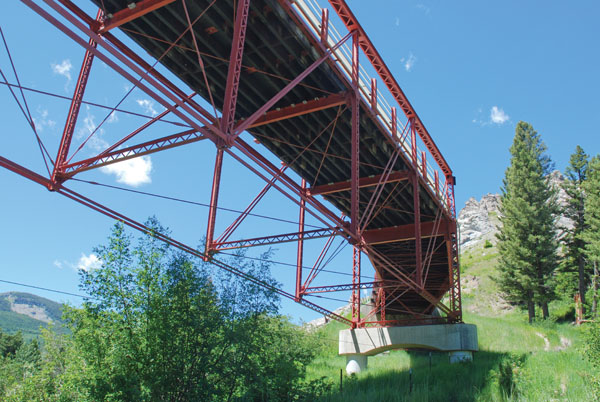
The Dearborn River High Bridge is the only remaining pin-connected, half-deck truss in the United States. Pin-connections were standard to bridges built before automobiles became common to the state’s roadways. A rare design when built in 1897, the narrow Dearborn River High Bridge crosses the river over a gravel road about 18 miles south of Augusta on Secondary Highway 435. The bridge spans a deep gorge nearly 100 feet above the Dearborn River near the front range of the Rockies. The Montana Department of Transportation rebuilt the bridge’s crumbling foundation, repaired the trusses, replaced the deck, and repainted the structure in its original color. Today, the Dearborn River Bridge stands as a symbol of nineteenth and twenty-first century innovations.
The dawn of the automobile age demanded changes in bridge technology to accommodate the new mode of transportation. The automobile was the primary reason for the legislature’s creation of the Montana State Highway Commission in 1913, which also mandated the formation of a bridge department two years later. The new department soon standardized bridge designs for steel, reinforced concrete, and timber bridges. In August 1915, the commission oversaw its first bridge project, across the Bitterroot River near Florence. Sixty-eight bridge projects followed over the next year. The highway commission’s bridge department designed bridges for automobiles, not wagons.
The Natural Pier Bridge
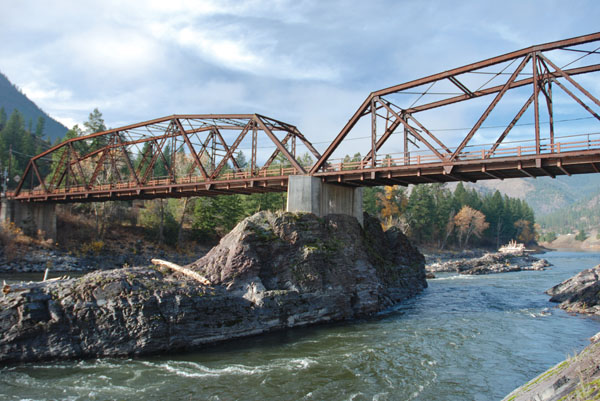
In 1917, the Lord Construction Company built a steel truss bridge across the Clark Fork in Mineral County. The bridge crosses the river about a mile northwest of Alberton on the South Frontage Road at the head of the spectacular Alberton Gorge. It consists of two Warren truss spans with the center pier resting on a natural rock outcrop in the scenic river canyon. Warren trusses, are characterized by the “W” configuration of the structural members when viewed from the side. They also identify it as a highway commission-designed structure. The bridge was once an important part of the Yellowstone Trail, an early 20th-century interstate highway, in western Montana. Like the Dearborn River High Bridge, the MDT rehabilitated the Natural Pier Bridge several years ago. It represents innovative design and making the best use of the landscape at hand.
The Carter Bridge
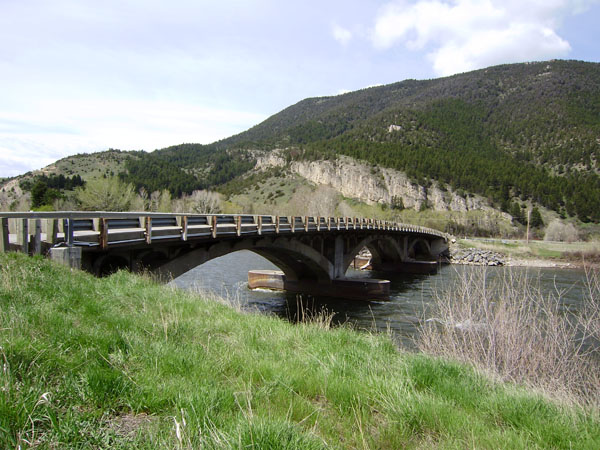
It’s hard to take a bad photograph here. The Carter Bridge crosses the Yellowstone River four miles south of Livingston on Secondary Highway 540, the old highway to Yellowstone National Park. The adjacent Carter Bridge Fishing Access Site provides a place for photographs of the structure. Built in 1921, the bridge is an adaptation of a design developed by Great Falls architect George Shanley for the 10th Street Bridge in that city. Concrete bridges became more common on Montana’s roads in the 1920s. Concrete combined function, durability, and aesthetics to provide a more streamlined structure that was also pleasing to the eye. The highway department built only a few large open spandrel arch bridges, like the Carter Bridge. All could be found in areas of scenic beauty to enhance the motoring experience for Montanans and tourists.
The Snowden Bridge
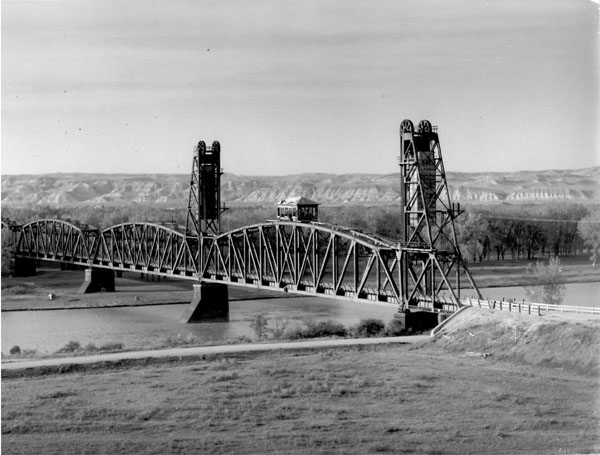
Montana is home to the longest vertical lift bridge in the United States. The Snowden Bridge crosses the Missouri River 15 miles southeast of Bainville, just off Secondary 327 near the Fort Union Trading Post National Historic Site. Built in 1913 by the Great Northern Railway, it is, perhaps, the most photographed bridge in the state. The 296-foot lift span was used infrequently, but mostly during the construction of Fort Peck Dam in the 1930s. Using concrete counterweights, the lift operator raised the span for barges destined for the dam site from a small shed on top of the bridge. For a time, the Snowden Bridge served as the state’s only toll bridge.
The Fallon Bridge
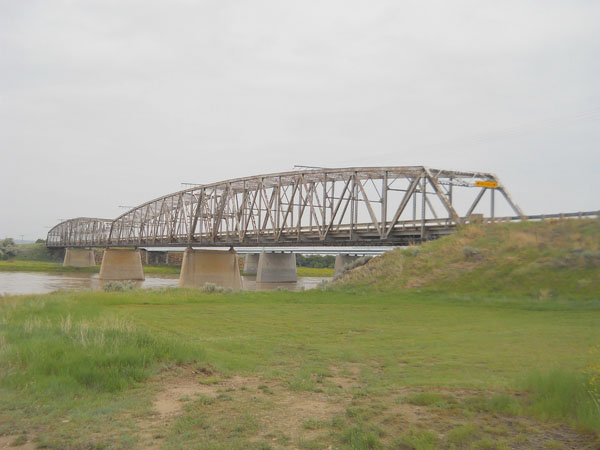
This spectacular bridge rises like a silver cloud from the northern Great Plains of southeastern Montana. The bridge crosses the Yellowstone River on the frontage road a mile north of Fallon 29 miles southwest of Glendive. The bridge was one of the few highway projects built during World War II. An ice jam destroyed the original bridge in 1943. The highway commission hired William Roscoe, Montana’s ace bridge-builder at the time, to build a new structure as quickly as possible. Manpower shortages, especially in steelworkers, forced him to look elsewhere for qualified workers. He found it on the Crow Reservation, which supplied most of the labor for the structure. When completed in November 1944, the Fallon Bridge was the most massive bridge in southeastern Montana.
Historic bridges are an integral part of the Montana landscape. Functional and visually appealing with their clean lines and often striking appearance. Meant by their designers to be taken for granted, they represent an important part of Montana’s transportation and social history. In many cases old bridges stand next to new ones, providing a remarkable example of how much Montana has changed and evolved over the past 150 years.
VIDEO: Historic Twin Sister RR Lift Bridges - Fairview and Snowden in Montana, MT
Cross the Yellowstone River on the abandoned Fairview Lift Bridge near Fairview, MT. and the Missouri River on its twin sister bridge, the Snowden Lift Bridge near Nohly, MT.


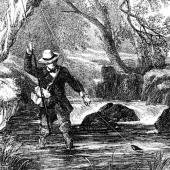






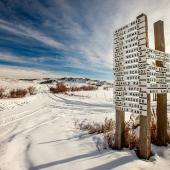
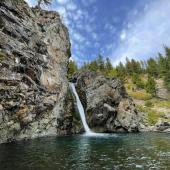
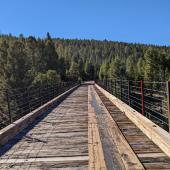
Leave a Comment Here